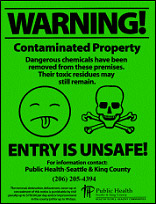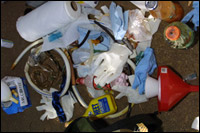Much has been made of the effects of methamphetamine on users, from crumbling teeth to erratic behavior to heart inflammation to death. It’s a painful story that the media has been only too eager to tell, as an estimated 346,000 people in the United States have become part of the meth-addiction “epidemic,” with a million more using the drug casually, according to the U.S. Department of Health and Human Services. But journalists and politicians have paid less attention to another damaging effect of the nation’s latest fixation: what meth is doing to the environment.

Lab leftovers.
Photo: Arizona DEC.
Unlike many illicit drugs, meth is composed of ingredients that are widely available for other purposes, including cold medicine and camp-stove fuel. Sources say every pound of meth manufactured generates six pounds of chemical waste. This illegal waste is usually dumped, ending up in sewers or septic systems, in backyards, and along roadsides and riverbanks. It frequently turns up in state and federal parks and forests.
Law-enforcement and environmental officials around the country say they’ve seen it all. But what are they doing about it?
With no national guidelines to follow, most states have devised their own cleanup standards. A pending bill in the House of Representatives would authorize the U.S. EPA to set national, voluntary standards. In the meantime, state officials are finding dump sites when they can, and calling in cleanup crews to mitigate the mess.
Here’s the Dirt
Western states like Washington, Oregon, and California have been dealing with meth since the Hells Angels motorcycle gang started producing it for the mass market in the 1970s and ’80s, says John Key, a hazardous-materials specialist for the Bureau of Land Management. Today, sophisticated “superlabs” dot the Pacific coast from Mexico to Washington, with an estimated 85 percent of such U.S. labs in California. Countless “mom-and-pop” labs operate around the country as well, although their environmental impact is much less significant.
Whatever the type, meth labs are notoriously dangerous places, where cooks combine a toxic brew that can cause burns, fires, or explosions. You can almost hear Molly Hatchet’s “Flirtin’ With Disaster” playing over the whole scene. Because of the instability of these chemicals — which include hydrochloric acid, benzene, acetone, ether, anhydrous ammonia, sodium and lithium metals, sulfuric acid, hexane, sodium hydroxide, iodine, red phosphorus, and more — they are generally dumped nearby, often within a five-mile radius, according to Key.
Soil contamination is a frequent issue at dump sites, says Don Plain of the California EPA’s Department of Toxic Substances Control. Such soil, if tested and deemed toxic, is disposed of in hazardous-waste facilities. But the current remediation technique isn’t exactly high-tech, as Plain explains: “If they dump waste on the ground, we try to scrape it up … We excavate however many feet down is required to get rid of contamination.”
Perhaps a bigger concern is the effect of these materials seeping into water. John Miesner, an environmental contaminants specialist for the U.S. Fish and Wildlife Service in Manhattan, Kan., says, “The three chemicals [having] the biggest impact on the environment are acetone, ether, and white gasoline. There are other ingredients that get dumped … but these are the ones that stick around long enough or are mobile enough to get into groundwater.”
He continues, “[These chemicals are] not fit for human consumption. They are poisonous when they’re in sufficient concentrations. And that would make the groundwater unfit for drinking or other uses, such as irrigation or livestock watering. In Kansas, that’s kind of a big deal.”
Art McEwen, an environmental-health specialist with the Yakima Health District in Washington state, says it is rare for a meth dump to contaminate an entire aquifer. But if that happens, he says, “It gets very complicated very quickly … There would be the potential of affecting other people’s wells and making other wells undrinkable. There are cancer-causing agents in this water.”
Others point out that meth doesn’t have to affect a whole aquifer to affect drinking water. Mary-Ellen Voss, spills program public information officer for the Washington Department of Ecology, says, “When labs are dumped … to a sewer line, it’s diluted enough that it’s probably not doing any harm. But … most of rural Washington is on septic systems [which release filtered wastewater back into the ground]. You rent your house out, someone dumps meth waste down the toilet, and you might not be aware of it until it comes back through your faucet.”
In some cases, chemicals are poured directly into rivers or ponds. Dan Doty, biologist with the Washington Department of Fish and Wildlife, says fish kills have helped inspectors find illegal dump sites. However, testing the water after the fact usually doesn’t prove anything, because the chemicals move downstream quickly. “A lot of times [the investigators will] go back, and they’ll find the evidence [such as empty containers] that this stuff was dumped,” he says. But by then it’s too late to protect the stream or nab the perpetrators.
Cleaning Agents
States that have been dealing with meth the longest — Washington, Oregon, Colorado, California, Alaska, Minnesota — tend to have the strictest cleanup standards, developed over time. But other regions have been getting a quick education as use of the drug has spread, and are struggling to devise solutions.
Typically, once law-enforcement officials find signs of a dump — such as trash bags, buckets, large drums, crystallized matter on the ground, dead plants, or glassware — they do mitigation themselves or call in a state department of ecology, health department, or private contracting firm. A safety assessment and hazard categorization test is then conducted, according to David Byers, response section manager for the spill prevention, preparedness, and response program of the Washington State Department of Ecology. This test determines which materials are flammable, acid, caustic, or spontaneously combustible. The materials are then sent to a hazardous-materials collections facility, where they’re sorted for final disposal and sent to regular landfills or hazardous-waste dumps.
It’s a dangerous job. Take, for instance, anhydrous ammonia, which is often stored in five-gallon propane tanks. These tanks have brass fittings, which the ammonia can corrode in a matter of weeks. “If you’re around, it’ll be a bad day,” Byers says. “Anhydrous ammonia is a poison. It will aggressively seek water to the point of tearing it out of its molecular structure. For example, if you take a dollar bill and dip it in anhydrous ammonia … the anhydrous ammonia will pull out the water and shrink the dollar bill to one-tenth of its normal size. It’ll do the same thing to your skin, your lungs, your eyes.” This poses a danger to both cooks and cleanup crews.

Sign of the times.
Photo: King County, Wash.
Even after local authorities clean up the mess, some hazmat facilities shy away from the waste. David Green of Sage Earth Sciences Inc, an environmental assessment and site remediation company based in Zillah, Wash., says, “It depends on what’s in it, but some places won’t take it because it’s classified as meth waste, and the facility just won’t take the risk. Even a facility that will take petroleum-contaminated waste won’t take it because the manufacturing process can potentially produce ‘warfare’ agents, like phosphine, which is a nerve agent.”
In an effort to regularize this increasingly necessary process, Rep. Bart Gordon (R-Tenn.) in February introduced into the U.S. House the Methamphetamine Remediation Research Act of 2005 [PDF]. The bill, currently languishing on the calendar, would authorize the EPA and the National Institute of Standards and Technology to research how best to clean former labs and dump sites, and set voluntary guidelines for the states.
While such national standards could help, some states are worried about the costs that could be incurred along the way. Brad Harris, environmental specialist with the emergency-response section of Missouri’s Department of Natural Resources, says his state would likely follow EPA’s guidance, but not without hesitation. “We don’t want to create an undue economic burden on a homeowner if it’s not needed,” he says. “Why should the state mandate [cleanups] if there’s no scientific basis for it? We’re still struggling with that, but we’re comfortable with the fact that the [cleanup] guidance we’re giving the public right now is sound.”
Dump Change
Perhaps the biggest environmental concern of all is the number of labs and dumps that go undiscovered. Commander Robert Knill of the California Methamphetamine Multi-jurisdictional Enforcement Team, which specializes in investigating superlabs, says that 75 percent of the nation’s superlab waste is probably never found, and 95 percent of all lab waste goes undetected. Sources say a lack of funding, combined with the sheer size of their states, makes detection nearly impossible.
Knill works in Shasta County, in the far north of the state. “Here in rural California, where you’ve got thousands and thousands of acres, it’s easy [for cooks] to conceal what they’re doing, and they just dump stuff wherever they feel like it,” Knill says. “It’s so remote that unless we get a tip, we’ll never see them.”
Washington Department of Ecology’s Dick Logan, a natural-resource damage assessment coordinator, concurs. “I would imagine that there are lots of undiscovered dump sites out there at this moment … We have a big state, and there’s a lot of open land.”
These officials worry that when dumps are discovered, it’s not always by those who know how to handle them. Key describes finding a cartel’s waste on BLM land in California’s Riverside County. It was packaged in ten 55-gallon trash bags tied with duct tape. “The bags break down, and … there was a subdivision nearby. It was a popular area for kids on dirt bikes. Somebody could have been getting into the materials.”
“When people discover these [dumps] alongside the roads, they can be very dangerous,” Logan confirms. He suggests that those who encounter suspected meth waste contact law enforcement and refrain from touching the materials.
Karlyn Kaley, staff toxicologist with the Office of Environmental Health Hazard Assessment for California EPA, says public education is necessary. “There’s potential for public exposure that certainly warrants more attention,” she says. “It is a public-health and environmental concern.”
Ultimately, as law enforcement, ecology, and health departments across the country scramble to often literally put out fires that the illegal meth industry brings to their communities, many environmental effects are going undocumented.
“We haven’t spent a lot of time trying to find the [environmental] consequences at this time,” Logan says. “So far we’ve been lucky with limited environmental damage, but I’m sure it’ll pick up as more of this goes on.”


